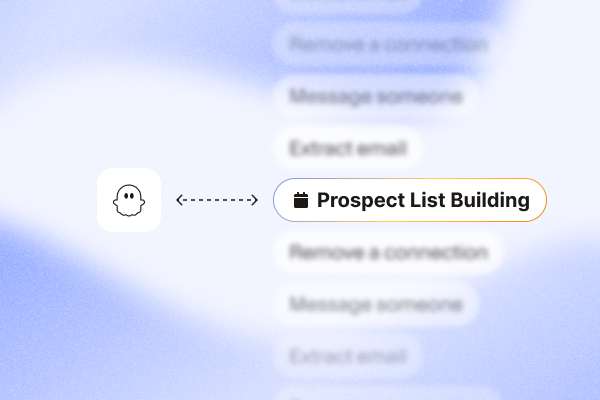This article covers the steps to build a prospecting list that aligns with your company’s ideal customer profile (ICP) and target market for more active and effective lead generation and what your prospect list should contain.
AI highlights
- A prospect list is a curated database of potential customers identified as relevant targets for your sales team. It includes company name, industry, contact information, job titles, and intent data to facilitate targeted outreach and increase conversion rates.
- The main difference between a prospect list and a lead List is that a prospect list identifies high-quality prospects likely to become valuable customers, while a lead list includes contacts showing initial interest, requiring further qualification.
- Steps to Create a Prospect List:
- Analyze Current Clients: Develop an Ideal Customer Profile (ICP) by examining successful clients’ traits, including company size, industry, and decision-makers.
- Use LinkedIn Sales Navigator: Filter and export data based on the ICP, and sync with your CRM for automatic leads.
- Gather Data from Multiple Sources: Build a qualified prospect list by collecting data from event attendees or individuals engaging with competitors.
- Enrich Your List: Use tools like PhantomBuster’s LinkedIn Profile Scraper to add detailed contact information and validate leads against your ICP.
- Implement Lead Scoring: Rank leads based on conversion potential and prioritize outreach accordingly.
- Sync with Your CRM: Ensure your CRM is synchronized with your prospecting list for consistent messaging and data management.
- Personalize Outreach Messages: Use AI tools to create targeted messages addressing prospects’ pain points.
- Plan Your Outreach: Develop a sales cadence and segment prospects based on lead scores and sales funnel stages in your CRM.
- Sales Prospecting Compliance: Avoid buying lead data lists to prevent compliance issues. Focus on organic prospecting through intent data and ensure GDPR compliance by maintaining clear privacy policies and regular audits.
- Building a Prospect List Using Intent Data: Leverage sales tools to create a tailored sales contact list based on buyer personas, online activity, and conversion potential.
- Recommended Prospecting Tools and Templates:
- Use PhantomBuster to track intent signals and extract lead lists.
- Build lists of competitors’ commenters, specific event attendees, and individuals engaging with industry influencers.
- Monitor job title changes to identify new qualified prospects.
- Prospecting List Checklist: When selecting prospecting tools, prioritize compliance, data quality, filtering options, enrichment capabilities, AI integration, automation, and CRM compatibility.
- Start a PhantomBuster free trial to automate lead generation and outreach, ensuring data accuracy and streamlining your sales process for better conversions.
What is a prospect list?
A prospect list is a curated database of potential customers identified as relevant targets for your sales team. It typically includes details such as company name, industry, contact information, job titles, and intent data, all of which aim to facilitate targeted outreach and increase conversion rates.
Prospect list vs. lead list
The main difference between a prospect list and a lead list is their focus and stage in the sales process. A prospect list is curated to identify high-quality prospects more likely to become valuable customers.
Conversely, a broader lead list includes contacts that have shown initial interest or engagement with your product.
Leads are gathered from various sources, like website sign-ups or marketing campaigns, and require further qualification to determine their potential as prospects. A lead list is the foundation for a more refined prospect list, guiding sales teams in their outreach efforts.
Sales prospecting lists compliance
Avoid buying lead data lists. These can lead to compliance issues due to outdated data or prospects unaware they’ve had their details sold.
Focus on key practices to ensure compliance in your prospecting efforts, especially with the General Data Protection Regulation (GDPR).
Keep your privacy policy clear and accessible, regularly audit your systems to address issues, and promptly remove any contacts who opt out. You’ll comply with regulations and build trust with your prospects by staying proactive.
Instead of purchasing data, focus on finding prospects organically through intent data to build compliant and effective prospecting lists.
How to build a prospect list based on intent data
While data providers can offer lists of individuals within a specific sector, creating a sales contact list tailored to your existing buyer personas, online activity, and conversion potential is far more effective.
Here’s how to leverage sales tools to accomplish this efficiently.
1. Build your ideal prospects’ profile
The first step is to build an ICP to understand your buyer. This will help you identify relevant buying signals that you can use to find prospects for your list.
An Ideal Customer Profile (ICP) describes the perfect customer for your product or service. It goes beyond basic demographics and includes specific characteristics that make a prospect more likely to convert.
To create an effective ICP, start by analyzing your current customer base.
Identify the common traits among your most successful clients and consider company size, industry, location, and revenue factors.
Look into these organizations’ decision-makers, job titles, and challenges. Understanding these elements will help you tailor your outreach efforts and craft personalized messages that resonate with your target audience.
Once your ICP is established, use it as a guide to filter and prioritize prospects. This strategic approach allows you to allocate resources efficiently, focusing on high-value prospects with a higher likelihood of conversion.
2. Use LinkedIn Sales Navigator lists for fresh data points
Once you understand your ideal prospect well, use the advanced search filters inside Sales Navigator to find the right prospects.
For example, use a job title and location, and try different boolean search operators to narrow your search.
Export these lists to your CRM for further enrichment and qualification.
While LinkedIn Sales Navigator doesn’t offer this option directly, you can use tools like PhantomBuster to export to a spreadsheet, including their contact details, which can be easily uploaded to your CRM.
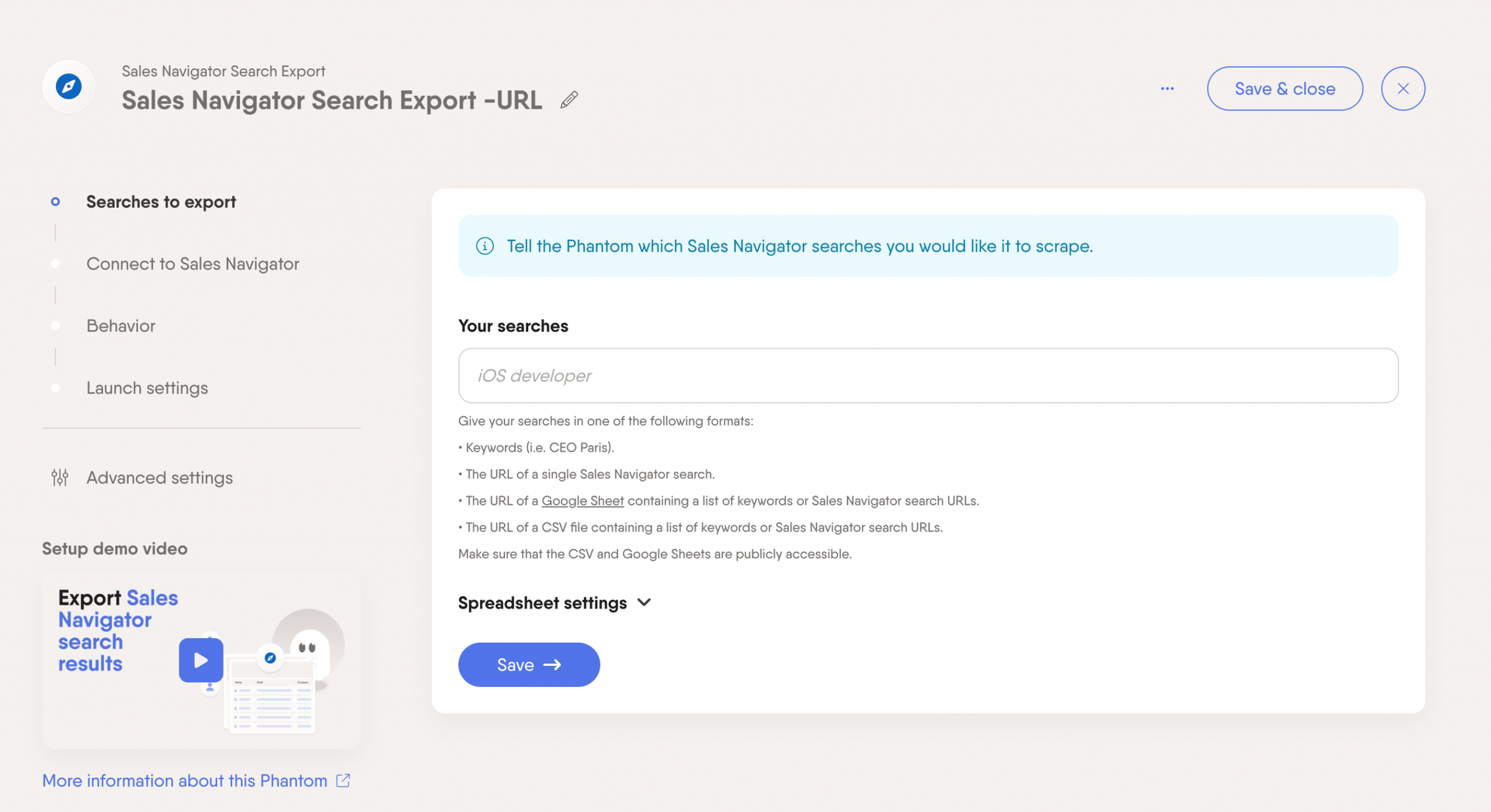
3. Use a prospecting tool to build a prospect list based on intent signals
Intent signals are indicators that a potential customer is actively seeking a solution or displaying interest in a product or service similar to yours. Examples of intent signals include job change tracking, engaging with industry influencers, or interacting with competitor content.
By identifying these signals, you can target prospects more likely to convert.
We recommend using PhantomBuster to track intent signals and extract lead lists based on them.
For example, you can monitor LinkedIn for people commenting on or liking posts from competitors or industry influencers, signaling their interest.
Additionally, track job changes within existing prospect lists, identifying potential customers who may be able to consider new solutions.
![]()
By automating these processes, you can build highly targeted and relevant prospect lists, saving time and ensuring outreach efforts are directed at the most promising leads.
4. Enrich your sales prospect list with more data points
Enrich your sales prospect list by adding detailed contact information from LinkedIn profiles.
Use PhantomBuster’s LinkedIn Profile Scraper to extract accurate contact data and sync it with your CRM leads.
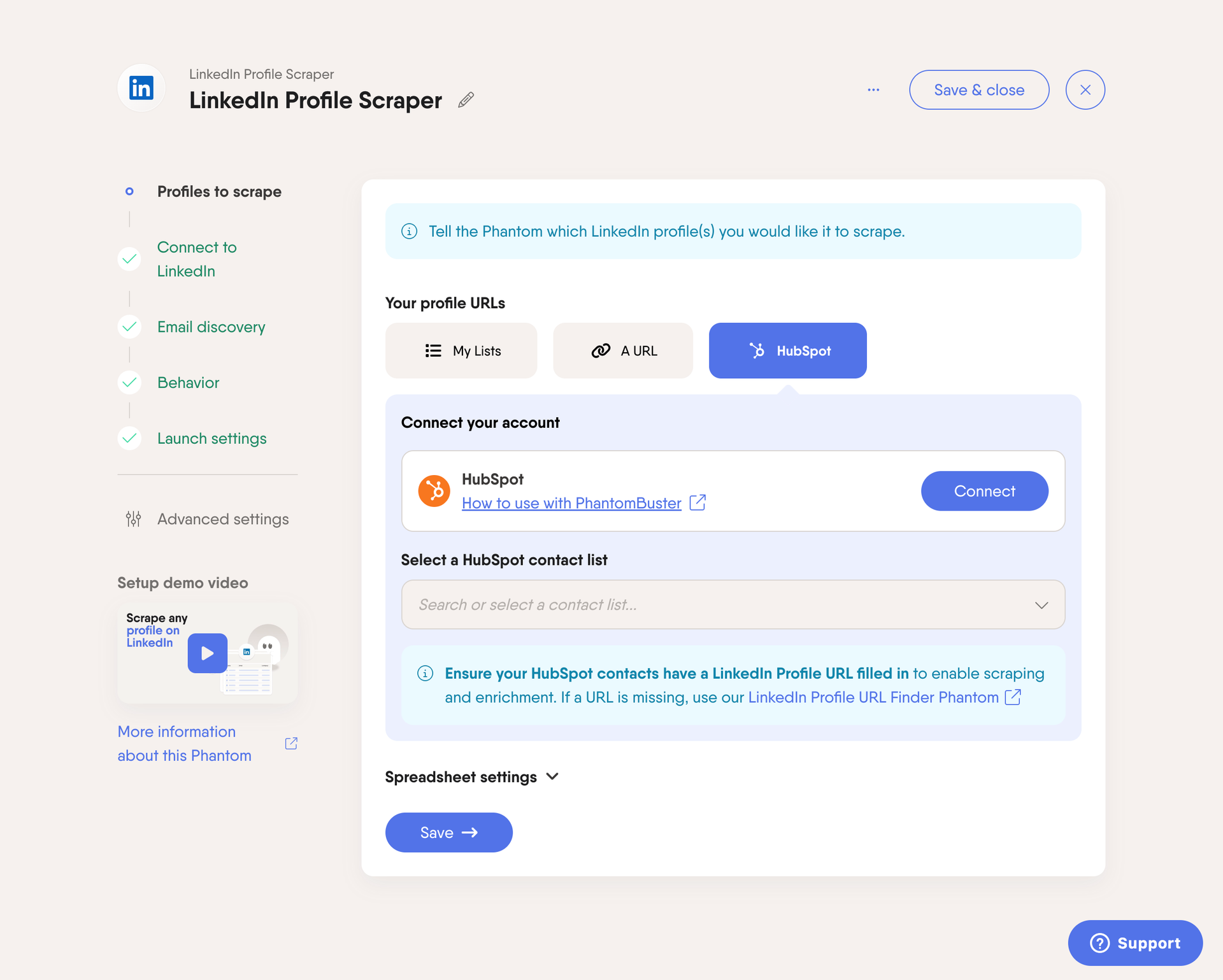
This will enrich your lead list with details, such as email address, current and previous job titles, location, educational history, and the number of connections.
5. Prioritize prospects using lead scores
Lead scoring is an essential component of the sales process. It uses a numeric system to rank leads based on their conversion potential.
The higher the score, the more qualified the lead, indicating a greater likelihood of conversion.
Scores can be assigned based on specific actions that signal interest.
For example, you might allocate +10 points to a lead who visits your pricing page or +5 points for downloading a whitepaper.
We recommend using the AI LinkedIn Profile Enricher automation and customizing prompts with criteria tailored to your lead scoring system.
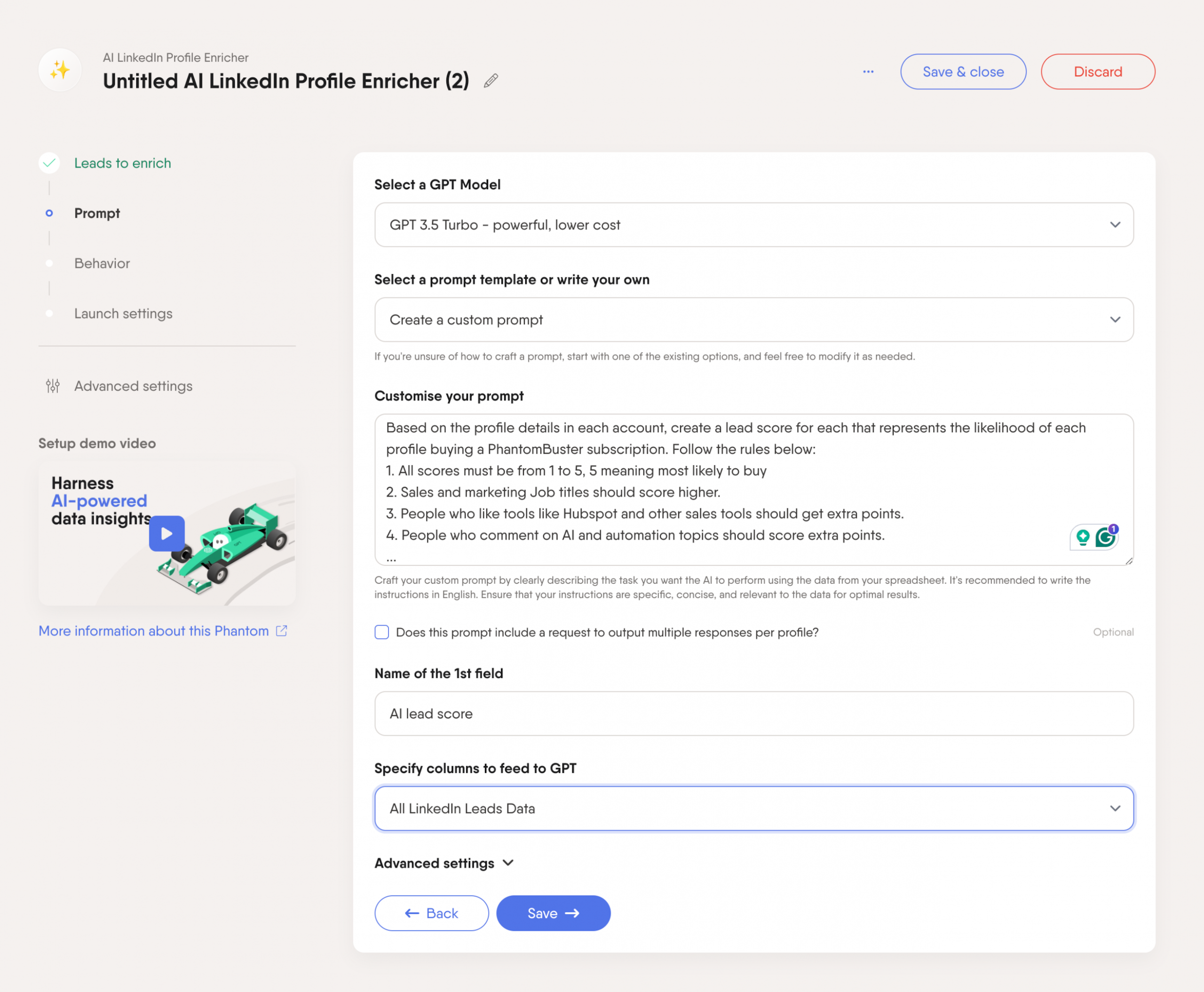
You can then prioritize outreach based on the AI scores.
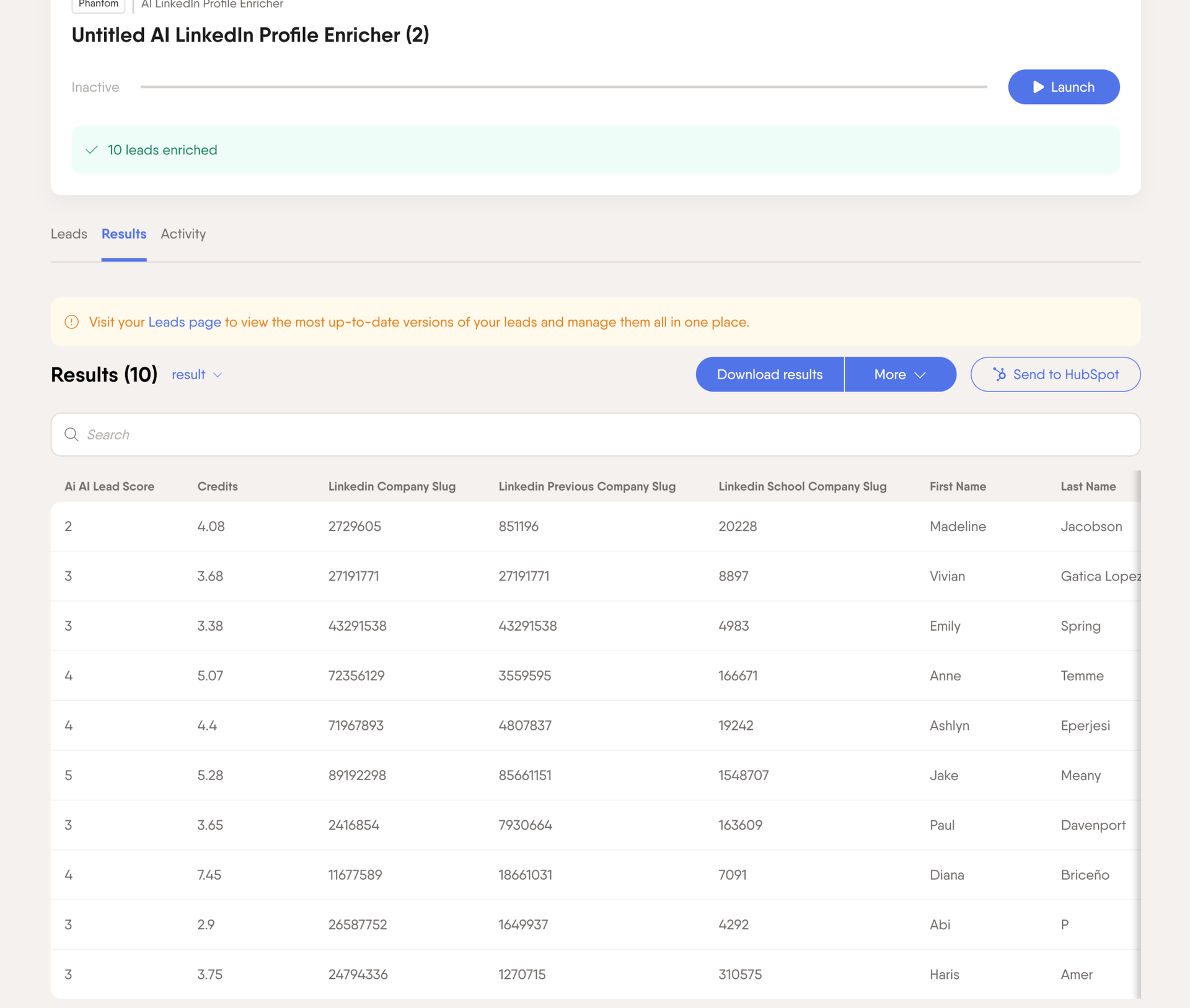
6. Sync your prospect lists into your CRM
Before you start reaching out to prospects, make sure your CRM is fully synchronized with your prospecting list.
This maintains consistent messaging and efficient data management, providing sales and marketing teams with a unified data pool for improved collaboration.
If HubSpot is your preferred CRM, integrating the prospect data you’ve gathered is straightforward and efficient. We suggest using the HubSpot Contact automation to sync the data you’ve collected into your CRM.
You can map various PhantomBuster fields to HubSpot contact properties, allowing you to choose which specific properties you’d like to update or overwrite.

7. Use AI to personalize outreach messages
You can start personalizing outreach messages with all the data you’ve gathered.
Use AI tools to analyze prospect data in your lists and build targeted messages based on it.
The AI LinkedIn Message Writer automation can help you write messages with the perfect tone with ready-made prompts and customizable message templates.
Let AI create outreach messages that address the prospect’s pain points, using tailored prompts to ensure relevance.
For example, choose the “Connect based on similar work experience” or “Connect with anyone” prompt for a more generic connection request.
You can also “Create a custom prompt,” and provide detailed instructions for tone, message specifics, and sign-off, ensuring your initial outreach efforts are effective and engaging.
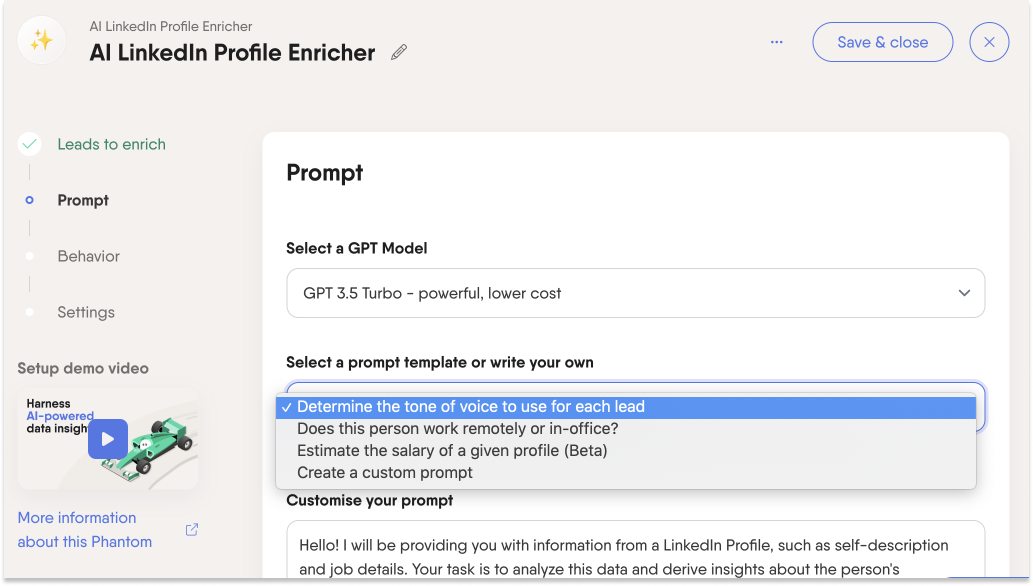
8. Plan your outreach
Now, you have an excellent prospecting list and a plan to keep your CRM connected.
To set the pace for high-value prospects, develop a sales cadence by planning your outreach efforts based on segmentation and lead scoring.
Look at previous deals and see which cadences performed best for different segments, then:
- Leverage the AI LinkedIn Post Responder to quickly write comments for the most impactful posts posted on LinkedIn in the last month.
- Schedule and automatically post your AI written LinkedIn posts
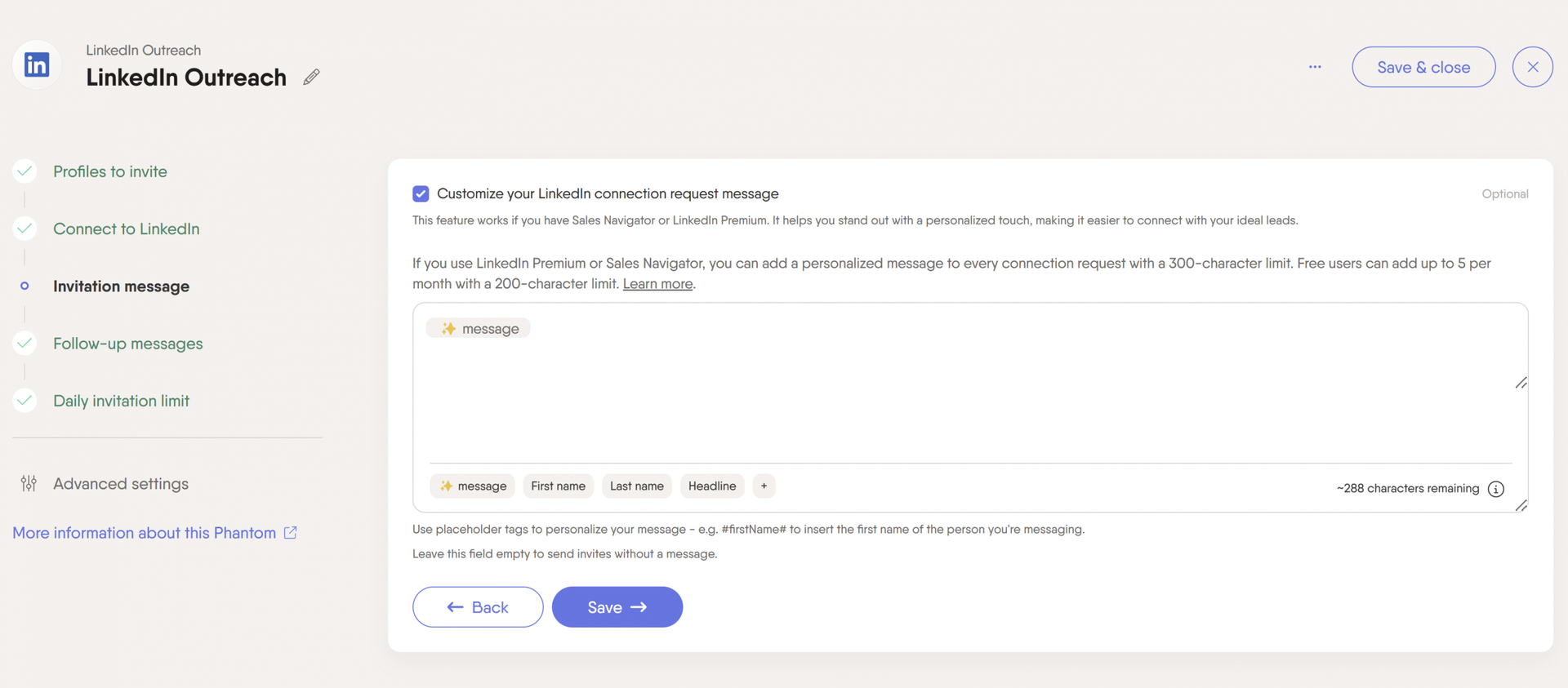
What should a prospect list include?
A prospect list should include information that helps identify potential customers and prioritize sales efforts.
Key elements of a prospect list:
- Company details:
- Company name: Always know who you’re targeting.
- Industry: Helps you tailor your message to fit their specific needs.
- Prospective client information:
- Name and job title: Reach out to the decision-makers or those who influence them.
- Email and phone number: Direct contacts make it easier to start a conversation.
- Advanced data:
- Buyer intent: Identify leads already looking for a solution like yours.
- Technographics: Know what tools they’re using to spot integration opportunities.
- Triggers: Watch for changes like leadership shifts or funding rounds—they often signal a good time to reach out.
Sales prospecting list templates using intent data
To build highly accurate and relevant lead lists, you can try out these prospecting templates:
Prospect list of competitor’s commenters and likers on LinkedIn
What you need:
- Competitor page LinkedIn URL
- A LinkedIn account
With PhantomBuster’s Comment and Scraper automation, sales reps can easily scrape the profiles of individuals interacting with a company’s LinkedIn posts.
It’s the perfect tool for tracking intent signals from qualified prospects and reaching out to people who want or need to hear from you and should be on your prospecting list.
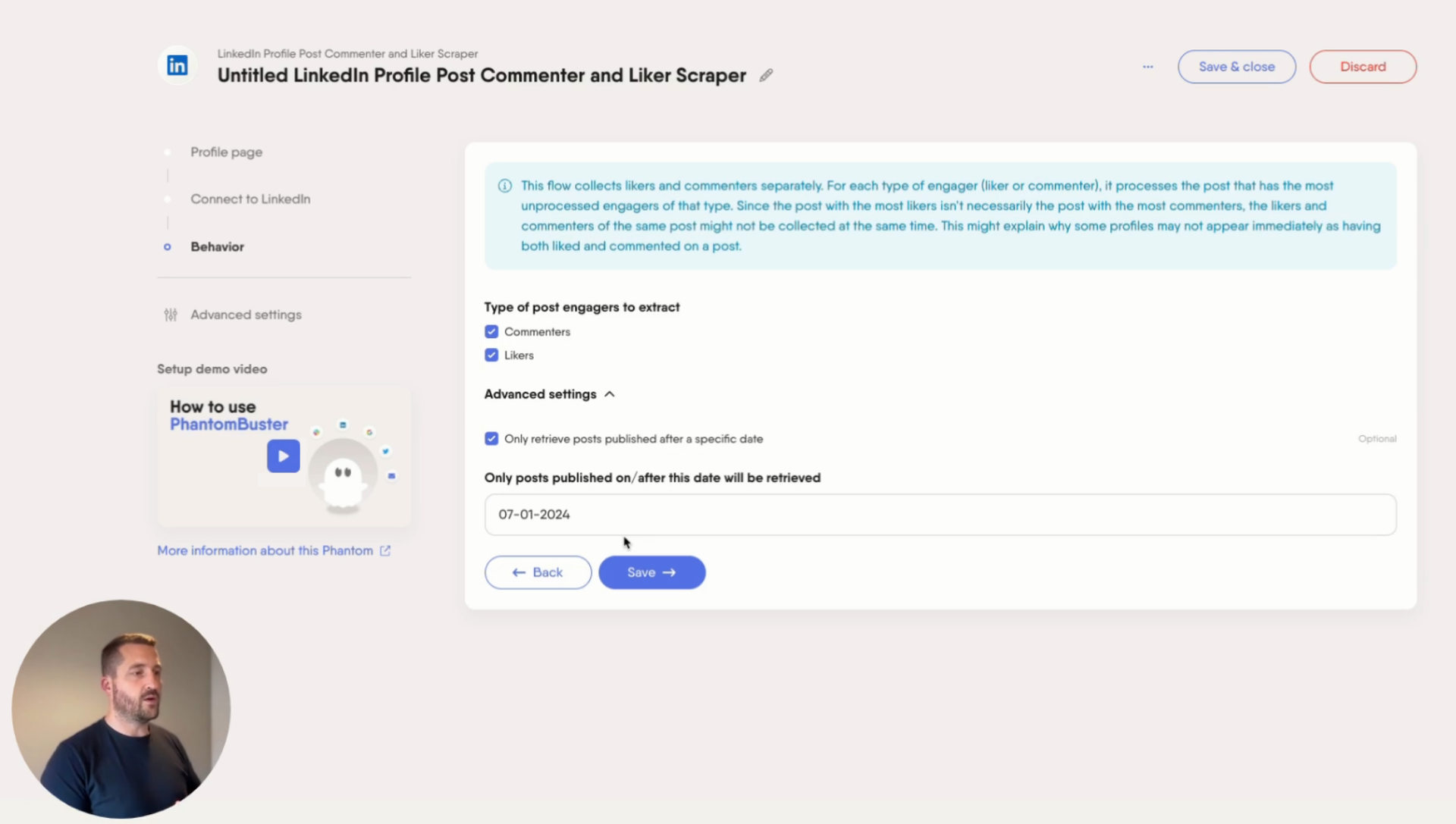
Prospect list of specific event attendees
What you need:
- LinkedIn event URL (you must be an attendee, too)
- A LinkedIn account
We recommend using the LinkedIn Event Guest Exporter to extract profiles of people who attended relevant events from a URL on a Google spreadsheet, a LinkedIn event URL, or a publicly available CSV URL.
Attendees have shown clear interest, so they’re more likely to convert, making it great for a sales prospecting list.
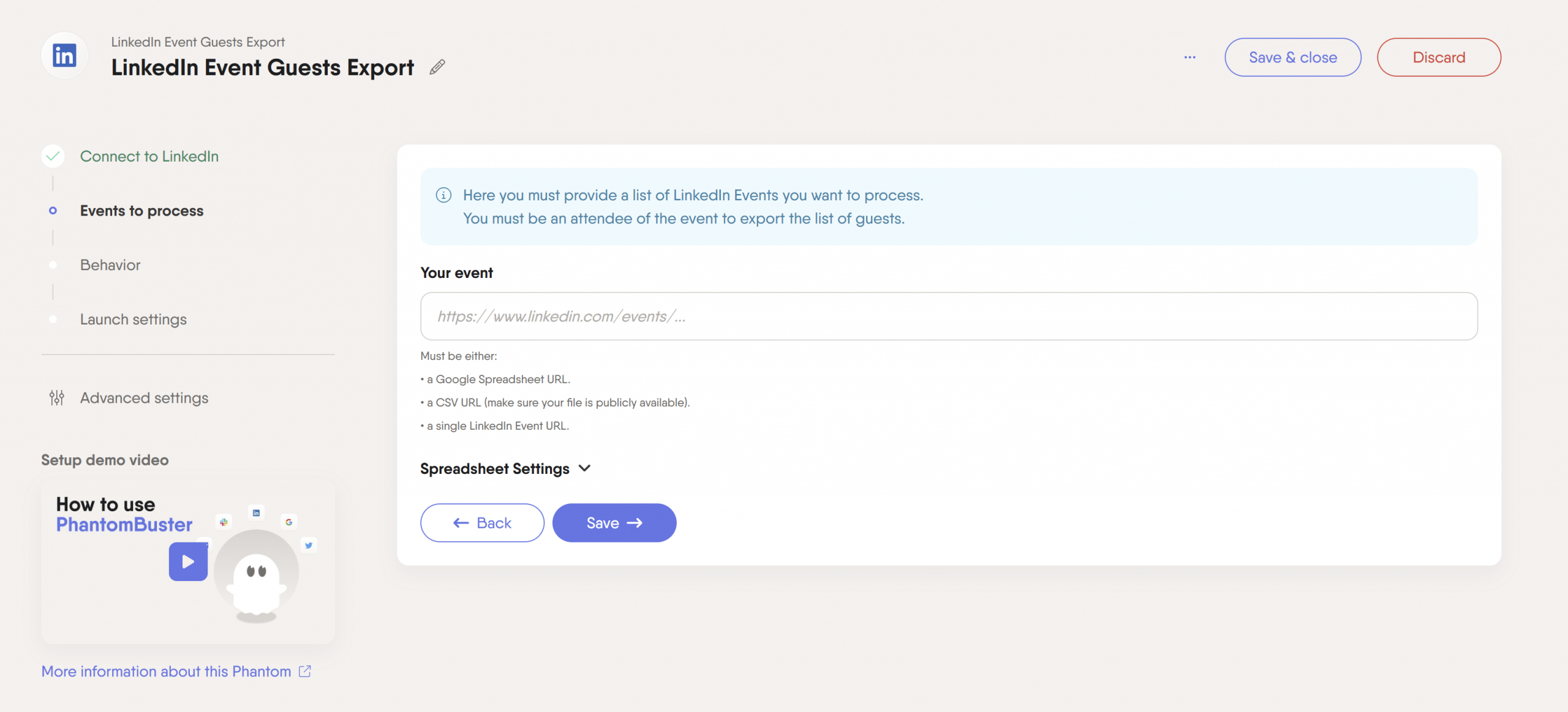
Prospect list of people who engage with an industry influencer
What you need:
- Influencer page LinkedIn URL
- A LinkedIn account
Instead of scanning manually for comments, you can use the LinkedIn Company Post Commenter and Liker Scraper to gather engagement data from posts from top influencers in the sector. See who’s leaving comments.
Add the influencer’s LinkedIn URL and collect the data in one place.
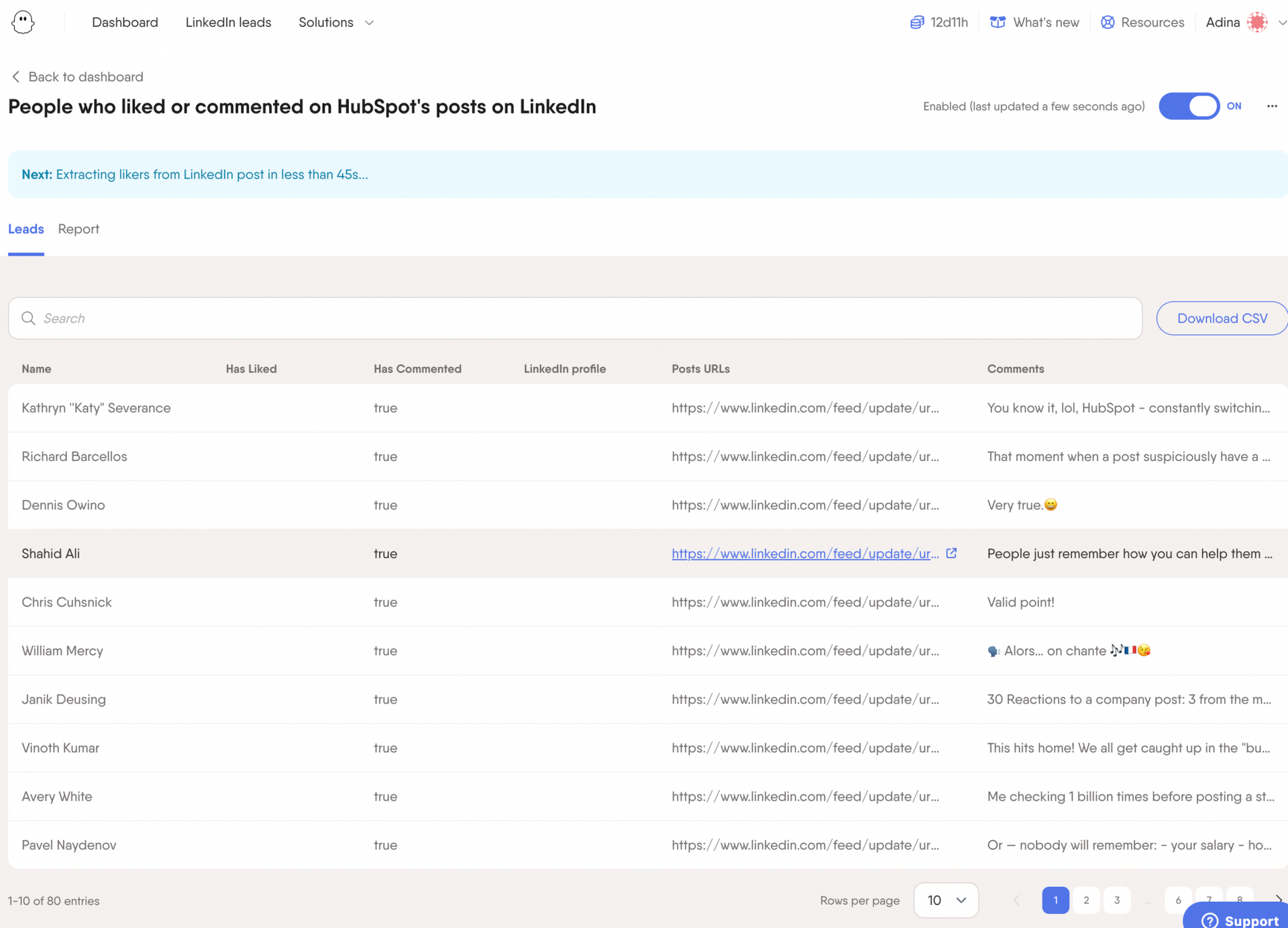
Prospect list of people who change their job titles
What you need:
- A HubSpot contacts lists (can be inbound leads too)
- A LinkedIn account
Anticipating significant company changes can be highly beneficial. When a former contact updates their job title, it may indicate they are now a qualified prospect, as their interest in your product might have changed.
The HubSpot Career Tracker automation monitors your HubSpot contacts and alerts you when they change companies or job roles so you can approach potential customers just when they need you.
![]()
Is a spreadsheet recommended for building a prospecting list?
You can use a spreadsheet for small information-gathering activities that you don’t need to update, but it’s not recommended for a long-term effective sales prospect list.
First, spreadsheets are manual and prone to human errors and manual work.
To obtain contact information, one would go through each company’s or individual’s LinkedIn page before copying and pasting. This can take a few minutes for each contact, which, with formatting time, soon adds up.
The information is also static, so it will not be visible if the prospect changes roles and email addresses or is active online. That’s why the easiest and most effective way to obtain prospect contact information is through lead generation tools.
Prospecting list checklist for choosing the best provider
When selecting tools for building your sales prospect list, prioritize factors from your sales prospecting tool like compliance, data quality, ease of use, and integration with your CRM.
- Filtering prospects – Make sure you have plenty of variables and options for filtering and segmentation, such as revenue and company size, online activities, and basic details like contact data.
- Enrichment – Ensure the prospect data is enriched for outreach campaigns that resonate with their activities.
- AI intelligence – See if AI supports the sales process by confirming the details on buyer personas.
- Automation – Look to see if the tool executes personalized activities automatically.
- CRM integration: Look for tools that offer bidirectional sync with your chosen CRM.
Build targeted prospect lists with PhantomBuster
Automating outbound lead generation saves time, but only if you use the right tools.
PhantomBuster is a powerful sales prospecting automation tool that helps you build accurate prospect lists and automate LinkedIn outreach to find potential customers.
You can use it to export targeted leads based on online behavior signals from social media platforms and uses AI to enrich and prioritize those leads.
- Export LinkedIn data and build accurate lists based on intent signals.
- Enrich lead lists with LinkedIn data or AI.
- Automate outreach on LinkedIn with personalized messages
- Sync lead data with HubSpot
Conclusion
Are you ready to elevate your prospecting strategy and transform basic contact details into comprehensive lists filled with high-value prospects?
With PhantomBuster, you can automate your lead generation efforts and focus on reaching the right prospects at the right time.
Take advantage of PhantomBuster’s 14-day free trial to experience the power of automation in building and managing your sales prospect lists.
Enhance your outreach campaigns, ensure data accuracy, and streamline your sales process today.
